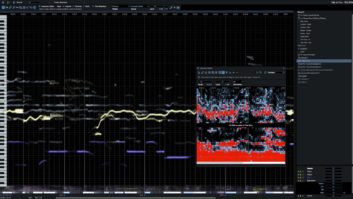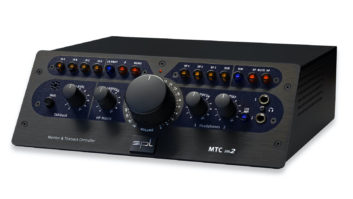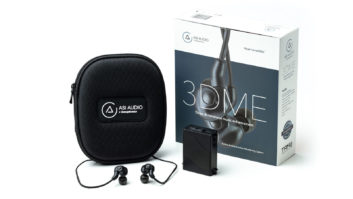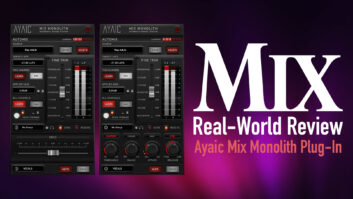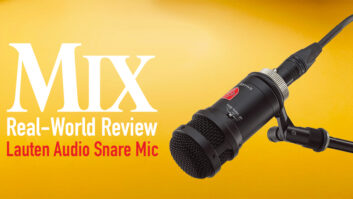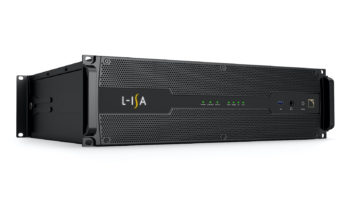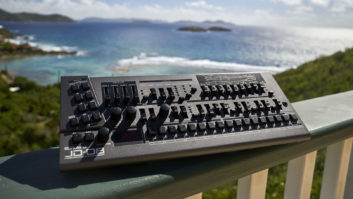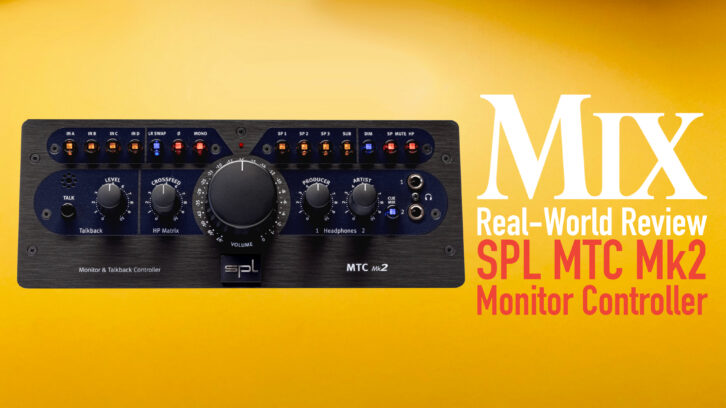
| MIX VERDICT: SPL MTC Mk2 Monitor Controller |
| THE TAKEAWAY: “I’m recommending the MK2 for its extensive feature set, excellent audio performance, durability and a sleek, sexy look that complements any room it resides in.” |
| COMPANY: SPL • www.spl.audio PRICE: $1,299 PROS: • Excellent headroom, noise and frequency response. • A wealth of features and conveniences, with smart design and styling. CONS: • A touch of leakage when fully attenuated. • Fewer routing options than original MTC. |
As a longtime user of SPL’s MTC 2381 monitor controller, I had mixed anticipation about the new MTC Mk2, thinking, “How might the company improve on the excellent design of a predecessor without sacrificing quality or features?” The short answer is they maintained the audio quality, added numerous modern conveniences and surrendered only a few routing flexibilities.
Being that a monitor controller acts like the center section of a mixing console for the modern digital studio, a tremendous amount of I/O is necessary, along with a neutral sonic profile, durability (for what will be constant usage) and flexibility of features to meet a sufficient number of studio needs (switching input sources, providing headphone outputs, routing cue mixes, providing talkback facilities, controlling monitor volume and control of mono fold-down, dim and mute functions, etc.).
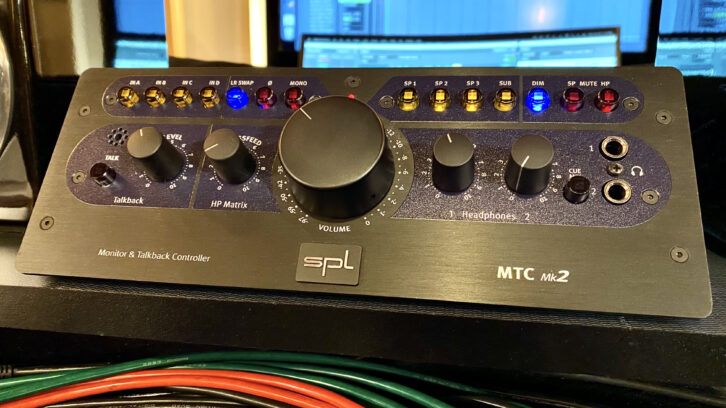
INS, OUTS, CONTROLS
Perhaps the most important feature upgrade isn’t terribly glamorous—an internal operating voltage of ±18V, which ensures high headroom, low noise, top sonic performance and indicates that this is serious professional equipment. The MTC Mk2 can handle 22.5 dB of level, about 1.5 dB more than typical ±15V devices. A switched-mode power supply automatically accepts 90 – 250 VAC at 50 or 60 Hz.
SPL has continued with the wedge-shaped form factor, with a moderate 10 x 11-inch footprint and a slanted, milled-steel faceplate. The top row of backlit colored buttons includes four pairs of stereo inputs—A thru D—with A, B and C on 1⁄4-inch TRS connections at +4 dB and D on RCAs at -10 dB. Input C is specifically the Cue Mix input and receives special routing treatment.
The unit includes four pairs of outputs for monitors SP1 to SP3, with output SP4 being a full-range mono output for connecting a subwoofer or feeding a mono speaker (e.g., a limited-bandwidth cube monitor). These switches do not toggle, as they allow multiple monitor outputs to be selected at once, just like the input buttons.
The top row of buttons also includes ample monitor functions, including L/R Swap, Phase (the difference between left and right channels) and Mono (the sum of left and right). Also: a Dim button for attenuating output by -10 dB and two Mute buttons (speakers and headphones) for convenience.
The lower row of knobs provides level controls, starting with Talkback, which includes a built-in condenser mic and momentary switch. The back panel also provides a 1⁄4-inch footswitch jack for convenience.
Next in line is Phonitor Matrix and crossfeed control, an entirely new feature borrowed from a number of other SPL products. This continuously variable control allows for the introduction of a touch of leakage between channels to make headphone listening more pleasurable and not as starkly hard-panned, actually a touch more mono, if you will.
The 45mm central aluminum knob/ potentiometer adjusts control-room monitoring levels via the four speaker outputs, ranging from -97 dB to 0 dB attenuation. This control is continuously variable, with no steps.
Finally, there’s a pair of headphone output controls (Producer and Artist) on the front panel, each with a 1⁄4-inch stereo jack. Producer is fed with whatever combination of inputs are selected for the speakers/monitors; the Artist control feeds the same, or only the Input C cue mix when the adjacent Cue Mix button is selected.
These are high-quality circuits, as SPL explains: “The output stage of the headphone amplifiers is designed as a push-pull amplifier in Class AB mode. The bipolar transistors share the amplification of the positive and negative half-waves, which produces a higher gain and a higher output voltage than in Class A operation, where only one transistor amplifies both half- waves.”
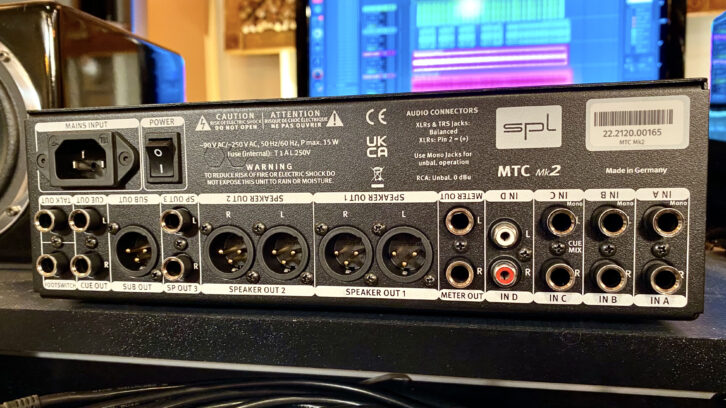
The back panel houses a pair of XLR outputs for SP1 and SP2, a pair of 1⁄4-inch TRS for SP3 and a single XLR for the Subwoofer output. The bottom of the unit houses a set of dip switches for attenuating output levels globally (-6, -10 or -13 dB) in order to get out of the first few degrees of travel with the big volume knob and with a bit more resolution.
There is also a Meter output, which is fed the same signal as the speaker outputs, just pre-fader (big volume knob). A Cue Mix output on a pair of TRS 1⁄4-inch jacks allows for an output including Talkback signal and switches to a direct feed from the Input C/Cue Mix input when the front panel Cue Mix button is engaged. A Talkback output is provided for routing talkback mic signal directly to a speaker (presumably in the performer’s room), and the Talkback switch 1⁄4-inch input is found here, as well.
IN SESSION
Once I switched over from my original MTC (quick and simple, as I already had all the right connections), I was able to tell that the Mk2 sounded no different than its predecessor, with no discernible noise, seemingly absolute linear frequency response, unrestrained headroom (all my monitors hit the beginnings of dynamics loss and non-linearity long before the MTC does) and plenty of punch.
The headphone amps sound particularly good, with ridiculous amounts of gain available (enough for higher-impedance cans) and great imaging; the addition of the Phonitor Matrix is also nice to have, if not essential. This feature would be in constant use for my casual listening, but for daily work, I find myself using it only when mixing, and even then only sparingly.
The backlit buttons, set against the flat-black front panel, are easy to see even in a dimly lit control room. The newer monitor control functions are all useful and make mixing sessions just a little easier. I have also found the Subwoofer output quite convenient for quick analysis of bottom-end tracking and mixing issues. I keep my 1⁄8-inch stereo mini-plug cable patched to Input D, which is pretty darn convenient for all the cellphone audio, which is an increasingly frequent part of working with my clients.
Lalal.ai Source Separation – A Mix Real-World Review
The one thing I don’t prefer with the new MTC Mk2 is the simplification of routing, which has sacrificed a few combinations. The original MTC had multiple knobs/faders for blending sources (the Cue input could be blended with any of the stereo inputs, with such blending available for the control-room speaker outputs as well as the cue-mix outputs). This was a bit more complicated in use and made for a more crowded front panel, to be sure, but with these features and a follower output, I was able to create three mixes (Cue 1, Cue 2 and control room) and accomplish very large live-tracking sessions without a cue mixing system! Yes, this was an intricate setup and not likely to be needed by anybody but power users, but I nonetheless still miss this level of superb routing flexibility.
One other minor quibble is the crosstalk performance of the main attenuator knob/pot. The control has leakage when fully attenuated; that is, there is still some audible audio, in the right channel only, when the knob is fully “off” (actually -97 dB). Using the global -10 dB attenuation nearly eliminates this minor problem.
Similarly, the left-to-right balance isn’t always balanced when the attenuator is within the beginning of its travel, although balance is even and stays even above that. Both of these behaviors are identical to the original MTC and could be alleviated by a stepped volume control, a wildly expensive feature found on mastering-grade equipment that is likely not economically feasible for this unit. Once again, using global -10 dB attenuation relegates this issue to insignificance.
THE FINAL MIX
I’ve been using the SPL MTC Mk2 for months now and it has become invisible in its application, dutifully doing its job without being apparent. If I’m not hearing dynamics, or detail, or punch, it simply isn’t in the mix—no guesswork.
At $1,299, the SPL MTC Mk2 inhabits a price range well above that of semipro units, yet well below mastering-grade and boutique units. This price-to-performance ratio is a great fit for smaller pro studios (especially those without mixing consoles), as well as personal studios and even artist-based production rooms that need more flexibility than a tabletop interface and software can allow.
I’m recommending the MK2 for its extensive feature set, excellent audio performance, durability and a sleek, sexy look that complements any room it resides in.
